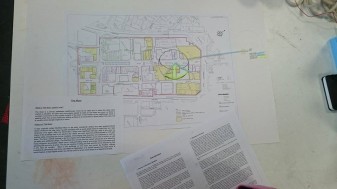Design process:
Experimentation:
Within our design we were aiming to challenge the nature of concrete so we came up with an innovative and exciting design. We were inspired by the contrast between comfort, as a characteristic of a hammock, and the hard quality of concrete by replacing the material that is usually laid upon with many cylindrical pieces of concrete (as shown in the drawings and pictures above). We experimented by casting concrete containing foam insulation and polystyrene balls as aggregates to reduce the weight of the concrete. When creating the model, shown above, we calculated that the weight of one of the test cylinders, about 1/20th of the weight of the final design, was 15kg. This gave us a problem as we realised that our innitial base would have failed to support a hammock weighing around 300 kgs. Therefore, the design was changed many times. Initially we planned to use two horse-shoe shaped concrete supports with steel bars to attach the hammock. However, during the process of testing the design, we realised that the two bases would fail and fall. Therefore, we changed the supports to help oppose the forces acting upon them by using additional steel and changing the shape of the bases.











